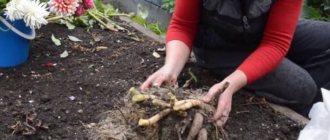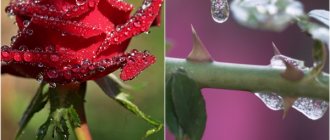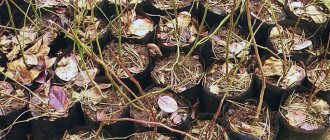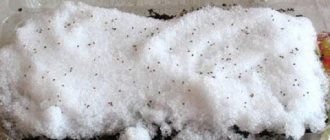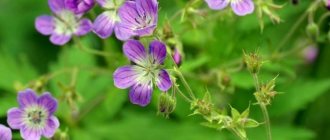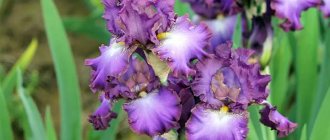Garden care from the moment of planting in open ground until autumn
Planting in open ground is carried out in a consistently warm time.
Immediately after sowing the seeds, calculate the approximate time when you will plant the gazania in open ground. This should be a period of no frost or severe cold. In this case, the soil should warm up by at least 40 cm.
Compost is poured onto a pre-selected sunny plot of land and dug up. Maintaining a distance of 20 cm from each other, holes are dug to a depth of 20 cm. Before lowering the peat pot into the ground, water the hole generously and add a tablespoon of fertilizer (potassium, superphosphate, soil).
How to care while growing
During growth, flowers are not watered heavily. Make sure that there are not many tall weeds growing around, which will block the sunlight necessary for the plant
Weeding the ground directly next to the gatsaniya must be done carefully so as not to damage the root, which is located quite close to the surface. This is why experts advise not to loosen the soil.
To prevent the soil from losing moisture and becoming covered with weeds, the soil must be mulched (peat or compost).
Do not forget to feed the plant once a month or a month and a half with a complete mineral fertilizer, which includes potassium, nitrogen and phosphorus.
How to prepare a plant for winter
Most often, with the arrival of winter, the bushes are cut off and the roots are dug up. However, if you want to keep a few flowering gazanias until next season, dig them up and plant them in a pot. At the same time, make sure that the lump of earth in which the plant grew all summer remains intact. Place the flower in a room with a temperature no higher than +8 or +10 degrees. It needs to be watered only when the soil is almost completely dry. With the arrival of spring, the stems are cut off and the roots are planted in a new bed.
What problems do gardeners have with growing and their solutions?
Both young and mature plants do not tolerate overwatering
Like all plants, gatsaniya is also susceptible to pests, from which it suffers and may die. These include slugs, aphids, spider mites, and snails.
Pest control methods:
- You can prevent the appearance of ticks and slugs by regularly weeding the area where gatsaniya grows, as well as pouring slaked lime between the bushes. In addition, spider mites can be killed with Ditox, Fufanon;
- It will be possible to get rid of snails only by manually collecting them, preventing further spread;
- To combat aphids, Aktara, Fitoverm, Biotlin are used.
If you notice that brown spots have appeared on the leaves, increasing in number every day, be prepared for the fact that the flower has been affected by gray rot. In this case, it will be very difficult to save the bush, so it is better to dig up heavily infected plants and take them away from the site. To prevent the occurrence of such a disease, you must follow the following rules:
- Do not overwater the gazania;
- Plant it in a well-lit place;
- The soil should be regularly ventilated, but free of drafts;
- For prevention, occasionally spray flowers with Fitosporin.
In some cases, gardeners claim that the plant does not bloom for a long time. The reason for this lies in improper care of gatsaniya or a bad place in which it grows.
Pests and diseases
Another attractive quality of gatsaniya is its high resistance to diseases and damage from insect pests, subject to all maintenance conditions.
Pests:
- Aphids, feeding on plant sap, weaken the immune system and create favorable conditions for the occurrence of infections. You need to fight aphids by combining folk remedies and special preparations - insecticides. Among folk remedies, garlic or tobacco infusion, a solution of laundry soap, pollination with ash and tobacco dust are effective;
- Snails and slugs interfere with the normal development of the plant by eating young green leaves. Method of control: manual collection of pests, installation of traps;
- Spider mites attack plants in low humidity conditions. For prevention during periods of drought, along with abundant watering, it is possible to irrigate plants. To combat - special means against spider mites.
Among the diseases of Gatsania, only gray rot threatens. The cause is high humidity, stagnation of moisture at the base and roots. To prevent disease when planting, provide the holes with good drainage and maintain the recommended distance between seedlings to avoid thickening. To combat the disease, the plant is treated with phytosporin and other fungicides.
Baskets of gatsaniya flowers, full of sunlight and warmth, lift your spirits and create a festive atmosphere in the area. And its unpretentiousness will inspire even a novice gardener.
Gatsania's resistance to pests and diseases is admirable. Problems with her health are so rare that many gardeners are sure that she is not sick at all. Only sometimes the bushes are attacked by spider mites and aphids. To kill insects, use any potent insecticide. Such drugs as “Inta-Vir”, “Agravertin”, “Akarin” (against aphids), “Kleschevit”, “Fufanon”, “Aktellik” (against ticks) are suitable.
High room temperature and systematic flooding of gatsaniya can provoke the development of gray rot. It will be extremely difficult to save diseased plants. Dispose of severely affected specimens first. Isolate the remaining bushes, treat them with a fungicide (Fitosporin, Fundazol) and be sure to adjust the schedule for further care.
We invite you to read: Strawberry Arosa - description of the variety
How difficult it is to grow gazania from seeds at home becomes clear after getting acquainted with its main diseases and the pests that bring them. Although the plant is considered disease-resistant, it is still subject to considerable risks. Aphids and slugs that have attacked the African chamomile can be collected very carefully by hand - the fragility of the flower will not allow them to be washed off with water. Planting strong-smelling garlic next to the flower will help avoid an attack. The smell of onions, sage and parsley also repels pests.
Spider mites do not tolerate insecticides, the solution of which must be sprayed on the flower and covered with a film for 2-3 days. Dampness caused by carelessness can lead to gray mold, which is difficult to combat. Prevention involves protecting leaves and flowers from water and fertilizers getting on them during watering and feeding. Rot that has already appeared is combated with Bordeaux mixture and other special preparations.
Did you know? Pests are afraid of strong aromas.
Nature has endowed gatsaniya with a generous scattering of such wonderful colors that the troubles of growing and caring for it will resonate in the hearts of home gardeners with love and satisfaction.
Was this article helpful?
Thank you for your opinion!
Write in the comments what questions you have not received an answer to, we will definitely respond!
You can recommend this article to your friends!
You can recommend this article to your friends!
Yes
No
Already helped 83 times
Gatsaniya - how to preserve in winter?
Gatsania is a unique heat-loving plant that migrated to us from hot Africa. More than 50 varieties of this wonderful flower are grown in our latitudes. But even after the “move,” this plant remained true to its heat-loving habits. Despite the fact that by its nature gatsaniya is a perennial plant, it cannot withstand wintering in our latitudes. If it is not preserved until spring by transplanting, then, unfortunately, it will die. The potential of this wonderful flower is enormous; if you replant it, it continues to bloom for quite a long time. So, let's figure out how to help this heat-loving plant overwinter.
How to protect gatsaniya from cold weather?
The warm days have passed quickly, the cold will soon come. It's time to think about what to do with the blooming gazania, and how to preserve it in winter? A short-term drop in temperature does not have any negative effect on the plant, but long-term hypothermia is certain death for it. So how to preserve gatsaniya until spring, so that these marvelous flowers will be the first to appear on your site after wintering?
- The option of growing gatsania in flowerpots is becoming increasingly common. With this method of planting, there are no problems with wintering plants. Before the first frost, gatsaniya is brought into the house, where it allows you to enjoy its blooms for a long time, even when winter is raging outside the window.
- Gatsania can also be transplanted into a greenhouse; the only conditions are good lighting and a temperature of at least +10 degrees. In the same way, the plant can be preserved on a glazed balcony. For replanting, pots with drainage holes must be used.
As you can understand, this plant can easily survive the winter if the necessary conditions are met. Some gardeners practice covering flowers with mulch. Others additionally cover them with a thick film, but it is reliably known that some plants still cannot tolerate wintering and die.
This plant is quite unpretentious to care for. If you follow the recommendations from this section of advice, then your gatsaniya will overwinter well and quickly adapt after spring planting. So, where to start replanting plants?
- Do you want to see how gatsaniya winters and blooms in your home? You need to start by preparing the soil for replanting. Please note that the soil in the pots of wintering plants must be light and well-drained. The success of the event largely depends on properly prepared soil for the plant, so add drainage (vermiculite or expanded clay) to the bottom of the pot, and only fill the substrate on top.
- Be sure to take into account the fact that the plant is resistant to a lack of moisture in the soil, but painfully tolerates its excess. Many gardeners water a plant too much and then cannot understand why it dies. Due to the abundance of moisture and lack of sunlight, gatsaniya often dies more or even completely during the wintering period.
- Be sure to take into account when choosing a place for wintering gazania that the plant is demanding of sunlight. Since there is not enough of it in winter, additional artificial lighting can be used.
When replanting gatsaniya, be careful with the root of the plant; if it is damaged, the flower will most likely die. All the processes described in this material are difficult only at first glance. Having completed these manipulations just once, you will never again have the question of how to overwinter gatsanias or any other heat-loving flower. A little patience - and the result will definitely amaze you!
Long-shooting and hybrid gatsaniyas
In our latitudes, the most commonly grown perennial is the long shoot gazania, which grows in South Africa and has creeping, short stems. Flowering begins in August and continues until winter. The size of the flowers reaches 7 centimeters in diameter. The hybrid gatsaniya has a harsh structure, and the flower size is 7-8 cm in diameter and has orange, yellow and white colors. Gatsania grows as a bush. The flower of the hybrid differs in the structure of the leaves. They have a linear spatulate decor. From below, the leaves are cast in silver and resemble velvet and retain moisture in the flower. Thanks to this pubescence, the flower is not afraid of cold weather. Hybrid varieties of gatsania are in great demand among gardeners in the CIS. And for good reason. They are more suitable for our climate. Endowed with a large number of double and semi-double petals and large flower heads.
There are many basic and hybrid species of the presented plant. They delight with their bright colors: crimson, white, yellow, pink. Cream, bronze-lemon, orange, spotted, striped. Often the names are associated with the coloring of the flower. For example, there are types of gatsania, where there are mixtures of varieties: Solar Dance, Solar Light, Solar Glare, Divnoye Divo, Bonjour and many others.
General information
Verbena is a herbaceous plant, but some species can form something like a subshrub. If verbena is grown in a warm climate, you can expect to grow up to 1 m in height. Verbena leaves are characterized by their small size and hairy covering. The flowers are also small in size and at the same time form corollas, each of which usually has 5 petals. All flowers are collected in inflorescences. Flower colors can be very different: red, blue, yellow, etc.
Growing verbena flowers from seeds
If you choose this method of growing verbena, be prepared for the fact that seed germination depends on the type of plant.
Since some of them produce seeds with a dense shell, which noticeably slows down and complicates the development process.
However, here you can try cold treatment - you need to wrap the seeds in a damp cloth and place it in a bag that should not be transparent. After which it is placed in the refrigerator, in which it must remain for at least four days. This process is called stratification.
An educational video about different varieties of verbena and proper planting of seeds can be viewed here:
How to collect verbena seeds?
You need to collect the seeds when the capsules on the plant dry out and turn brown. It is necessary to cut off the inflorescences along with the boxes, place them somewhere and let them dry completely.
ATTENTION! It is recommended to turn the seeds occasionally to prevent them from molding. When the boxes are dry, you need to remove the seeds from them and use them as you wish.
When the boxes are dry, you need to remove the seeds from them and use them as you wish.
How to properly preserve gatsaniya in an apartment in winter until spring
Flower lovers will appreciate gatsaniya due to the variety of shades. Outwardly, it resembles the familiar chamomile, but with a bright color scheme. Summer residents love to grow annuals, but it makes sense to grow perennials
Therefore, it is important to know how to preserve gatsaniya in an apartment in winter, so that in summer the garden area will be full of bright flowers. Gatsaniya is grown in flowerpots, flower vases or containers and used to decorate the local area
Is it possible to save gatsaniya until spring?
In Russia, summer is short, so you need to make sure that gatsaniya calmly survives the winter cold. The flower can withstand temperatures up to a maximum of -5 degrees.
To preserve the plant until spring, there are several options:
- Transfer the flower indoors before the first cold weather appears. The method is the most harmless, since it does not involve interference with the root system.
- Transfer to a winter greenhouse or a fully glazed balcony. In this case, it is necessary to maintain a temperature above +10 degrees.
- Transplant into a special pot with automatic watering.
By observing simple care conditions, it is possible to preserve gatsaniya until spring.
Does gatsaniya overwinter in open ground?
In the central zone of Russia, many gardeners leave gatsaniya to winter in the open ground, covering it with insulating material. But, despite good shelter, most of the plants die because they cannot tolerate prolonged cold.
Preparing the plant for winter
Preparatory work for wintering is carried out in the fall, in October-November, when the air temperature drops to -5-7 degrees. Strong shoots are taken from gatsaniya and transplanted into flower pots. Then simply place it in a warm place.
For better wintering, the flower must be transferred gradually so that it has time to adapt to changing conditions. To do this, the pot is brought into the house at night for 3-4 days, and exposed to fresh air during the day. Thus, gatsaniya will comfortably overwinter.
When replanting a plant from open ground, you should follow some recommendations:
- Drainage preparation. Gatsaniya is sensitive to excess moisture, so it is recommended to use expanded clay as drainage.
- Land preparation. The most suitable soil is sandy loam containing a large amount of humus.
- Taking care of the roots. The root system is extremely sensitive and does not tolerate any damage, even death.
Like any plant, gatsaniya loves to be treated with care and care, although it is considered an unpretentious flower.
How to care?
The first thing you need to do after transplanting is to decide on the wintering location of the flower. Most gardeners prefer to store gatsaniya on the balcony, but if the conditions are unsuitable, they bring it into the apartment
It is important to provide the plant with a large amount of sunlight, so it is recommended to place it on a windowsill with a sunny side. Artificial lighting is also added, since the optimal time to receive light is at least 8 hours a day
An important aspect of gatsaniya care is maintaining optimal temperature. The flower loves temperatures from 20 degrees, but tolerates frosts down to -5, so a comfortable temperature for wintering is considered to be 8-11 degrees. Temperatures below threaten disease or death of the plant.
Water as needed (every couple of days). Excessive watering or drought will have a bad effect on the flower.
Possible difficulties and mistakes in care
Any self-respecting gardener can make mistakes when caring, since gatsaniya is considered a fragile plant. At the end of winter, some problems may appear:
- Lack of flowers. This is due to the incorrect content of the flower. There are several reasons - improper watering, insufficient sunlight or non-compliance with the temperature regime. To solve the problem, it is necessary to feed the plant with potassium and phosphorus. Nitrogen is fertilized in extreme cases.
- Damage to roots by gray rot. The only reason is overwatering the plant.
If, after all, the plant did not survive the winter, then it will have to be grown as seedlings from seeds. Gazania gets along with any plants without causing discomfort. There are a lot of flower varieties. A distinctive feature of some varieties is that when the sun sets, they fold their petals. The remaining views remain open all night.
The most important thing in caring for gatsaniya is care and love. If the plant is provided with all the conditions, it will always delight with its beauty and aroma in the garden.
How do these flowers feel in winter?
Such a unique flower as gatsania requires careful and thoughtful care, however, like all plants. But it won't be too burdensome for you. The plant needs light, fertile soil with good drainage.
When the flowers mature, they become cold-resistant and can be admired almost until the first frost. Although gatsania, a perennial or annual, is native to the south, it has already almost adapted to our latitudes.
Only when you already feel the onset of winter, carefully transplant your favorite flowers into pots. If you have a glazed balcony and the temperature there stays at least +10 degrees, then they will overwinter well in this place so that they can return to the garden plot in the spring. Don't forget about moderate watering.
What annuals can you keep at home in winter?
Adding an article to a new collection
Many of the annuals we are accustomed to are perennial plants in their homeland. They simply cannot withstand our harsh winters and die with the onset of cold weather. But you can take the flowers home, provide them with care, and return them to the flowerbed in the spring!
In warm regions of the country, petunias, impatiens, and eustomas bloom for more than one year, but in the middle zone they are usually grown as annuals. It's a shame, because these and many other plants still have the strength to grow and bloom. To preserve flowers until spring and thereby save time and money on growing new specimens, there are several ways.
Digging up a bush. A rather traumatic method, when the plant is dug up, placed in a pot and kept in the house, and in the spring it is planted in a flowerbed. In addition, the bush can take up a lot of space indoors, and its decorative value will also be reduced.
Preservation of rhizomes. In this case, the entire above-ground part is removed, and the rhizome is stored in the cellar. This option is convenient, but not suitable for all colors.
Transfer in a container. If the plant grew in a container or hanging pot, you can simply move it into the house or winter garden. This is the easiest way to save flyers.
Cuttings. A reliable method, although it requires special skills. To take cuttings, select the strongest plants and then root them at home.
Garden plants brought into the house must be temporarily isolated from indoor flowers in order to reduce the risk of pests attacking the latter. If after a couple of weeks there are signs of aphids, spider mites, etc., treat the plants with a soap solution (4-5 tablespoons of laundry soap per 1 liter of water) or ready-made insecticides.
When storing heat-loving perennials at home, various problems may arise. The main ones: lack of lighting and dry warm air. Therefore, it is best to make sure in advance that you have a bright, cool room
Also note that watering garden plants in winter should be minimal, and fertilizing is unacceptable. You need to pick up bushes from the flower garden before frosts begin, when they are still strong and not withered
We will look in more detail at how to preserve annuals in winter using specific examples.
How to preserve bacopa at home in winter
Bacopa is a beautiful hanging plant that is capable of perennial flowering. But in the cold conditions of the middle zone, the flower inevitably freezes out in winter. To prevent this from happening, move the plant and container to a draft-free room with a temperature of 8-15°C. Water the flower moderately, spray occasionally.
Since by the end of winter the bacopa bush finally loses its decorative effect, it is advisable not to return it to the flowerbed, but to use it for cuttings. The procedure can be performed from January to March. Select the healthiest shoots, cut off their top with two nodes to a length of about 10 cm and plant in a moist, fertile substrate so that the bottom node is underground: a root will form from it. Place the container with the cuttings in a warm place and water it regularly. In early May, plant strong plants in flowerpots and containers.
Growing gatsania seedlings from seeds at home
When choosing when to plant gazania grown from seeds, it is worth taking into account the climate zone. Plants are planted in the ground when the danger of frost passes - in the second half of May.
Gatsania seeds are collected after flowering. They look a little strange because they are very hairy. The seeds are spread in an even layer on a sunny windowsill. When they are dry enough, put them in an envelope for storage. There is no need to refrigerate the seeds.
Photo. Gatsania seeds.
Sowing seeds
- Seeds are sown in February - March.
- Sowing is carried out in pots, gatsaniya germinates quite quickly, after 2-3 days. In cold climates, it is worth pushing back the sowing date as much as possible to a later date, otherwise you will end up with seedlings that are too early. Cover the seeds with a thin layer of film, maintain the room temperature at 25 °C and sufficiently high air humidity.
- February. Shoots after 3 days.
- Seedlings after 2 weeks.
- Early March.
- 20th of March. After the plant matures (about 3 weeks), it should be picked and planted in pots with peat.
- A week later. When transplanting, select flower pots with a diameter of 9-10 centimeters. The temperature is maintained at least 18 °C.
- Seedlings in May. In open ground, seedlings are planted in increments of 20 × 20 cm.
You can sow the seeds directly into the ground at the end of April, the plants will bloom in about a month.
Gatsania can be propagated by your own or purchased cuttings. To propagate vegetatively, the mother plant must be large in size and have healthy leaves.
How to preserve Shabot cloves at home in winter
makesomethingdaily.com
Most carnations tolerate frost easily, but Chabot is an exception, so it is usually grown as an annual. From July to September the plant actively blooms, but you can preserve the heat-loving beauty until spring. The easiest way is to trim the carnation bushes, transplant them into separate pots and store them in a cellar or basement. Occasionally the soil needs to be watered to prevent drying out. At the beginning of March, place the plants in a bright room and increase watering. In April-May, transplant the surviving bushes into a flower bed.
You can try cutting carnation cuttings and rooting them following the example of gatsania, which we talked about above. Choose strong shoots at least 5 cm long, remove the lower pairs of leaves. Until spring, water the cuttings moderately and inspect them for pests. Plant in a flowerbed in spring when the soil has warmed up well. The flowering of young Shabot carnations will be more modest, unlike the mother plant, but you will be able to enjoy it earlier than usual.
Propagation of gatsaniya using cuttings
The best time for this is mid-summer. Just at this time, the annual or perennial gatsaniya is able to reproduce using cuttings. They are taken at the base of the stems. Side shoots are treated with drugs that stimulate root formation. After which, the seedlings are planted in the shade, where there should be no sun. In any case, the plant must adapt to the new location. After the cuttings take root, they are carefully planted together with a lump of earth in a permanent place. So in the selected area you can grow a beautiful gatsaniya flower.
Sow gatsania seeds
Caring for gatsaniya in the garden consists of moderate watering, followed by loosening the soil and removing weeds and timely removal of faded inflorescences so that the plant quickly forms new buds. Mulching the soil is also encouraged, as it allows you to retain moisture in the soil longer in the summer heat and reduces the amount of weeds on the site. Growing gatsaniya flowers also involves fertilizing with fertilizers: if your gatsaniya grows on fertile soil, you need to feed it once a month and a half with a solution of complete mineral fertilizer at the rate of 20-25 g per square meter, but if you planted it on rocky, poor soil, then You will have to fertilize once every 2-4 weeks.
Gatsania flowering.
Gatsania blooms from June to November, and the flowering of each basket lasts about three weeks. In the dark and in cloudy weather, the reed flowers of gatsania curl up, covering the yellow center of the tubular flowers.
Sometimes gardeners complain that gatsaniya does not want to bloom. This may be due to insufficient lighting, excessive watering, or transplanting seedlings into open ground too late. Try not to violate the agrotechnical requirements of gatsaniya, and it will bloom on time and abundantly.
Pests and diseases of gatsaniya.
Anyone who has grown gatsaniya will tell you that it does not get sick. But if growing conditions are unfavorable for the plant, it weakens, and then it can be affected by gray rot. You will have to remove diseased specimens and treat the remaining plants with phytosporin.
Among the insects that harm gatsania are snails, aphids and spider mites. Snails must be collected manually, and insects are destroyed with insecticides: aphids - fitoverm, akarin, inta-vir, and spider mites - actellik, fufanon or ditox.
Gatsaniya after flowering
How and when to collect gatsania seeds.
In our climatic conditions, gatsania seeds usually do not have time to ripen, unless the summer turns out to be hot, long and dry. In addition, mainly hybrid plant varieties are grown in culture, and their seeds do not retain species and varietal characteristics.
And the most important obstacle for those who want to collect gatsania seeds is that, like dandelion seeds, when ripe, they simply fly away. Therefore, when gatsaniya begins to bloom, wrap several large flowers with gauze so that the seeds do not scatter, and secure it to the peduncle.
Gatsaniya in winter.
If you grow gatsaniya as an annual, simply destroy the remains of the plant after flowering. But you can try to save it for next year.
To do this, the most beautiful still flowering bushes are dug up, transplanted into pots or boxes and stored in a well-lit room at a temperature of 8-10? C, watering them from time to time so that the soil does not dry out completely. In the spring, they are planted again in open ground, after shortening the shoots by half.
Types and varieties of gatsaniya
Gazania longiscapa
– annual 15-20 cm high, basal leaves entire, slightly split, pubescent below, bright green above. The basket, up to 7 cm in diameter, consists of tubular and reed flowers of bright yellow color, with the bases of the reeds being colored brown.
Gazania is harsh or shiny (Gazania rigens, Gazania splendens).
Stems up to 30 cm tall, baskets from 4.5 to 6 cm in diameter. The tubular flowers are blood-black, the ligulate flowers are bright yellow, red or orange with black, brown or white spots at the base. The leaves are usually entire, but sometimes pinnately divided.
Gazania pavonia
differs from others in the shape of the leaves - narrow, long (up to 20 cm). A basket up to 8 cm in diameter with yellow-orange reed flowers with a black base and a yellow center of tubular flowers. Also grown in cultivation are pinnate gazania (Gazania pinnata), snow-white gazania (Gazania nivea), single-flowered gazania (Gazania unifiora) and gazania hybrid (Gazania x hybrida), obtained by crossing various species, but mainly Gazania long-shooting and harsh. Hybrid Gatsania varieties developed in recent years are capable of blooming even on cloudy days. Of the most popular varieties of hybrid gatsania, it is worth mentioning:
– “Daybreak Red Stripe” – light yellow inflorescences with red stripes, opening in the morning and closing only at dusk; – “Talent” variety mixture – a hit in 2001 with beautiful leaves and inflorescences that close only at night; – “Ministar” variety group – varieties with yellow, white and orange baskets.
Is Gatsaniya sick?
She may contract a disease called gray rot. As you can see, the gazania plant can get sick, just like every living thing in the world. Growing (and caring for it) during this period will become a little more complicated in that you will need to resort to the help of a fungicide.
Treat the diseased flower with its solution. Preventative measures will also not be superfluous. They are simple: make sure that the flowers grow in non-waterlogged soil.
Also protect them from aphids, snails, slugs, and spider mites.
By performing such simple steps, you will constantly enjoy the bright exoticism of a native of Africa, and it will delight you at any time of the year. Wintering is not scary for her. So enjoy the sight of these beautiful flowers!
Adding an article to a new collection
Many of the annuals we are accustomed to are perennial plants in their homeland. They simply cannot withstand our harsh winters and die with the onset of cold weather. But you can take the flowers home, provide them with care, and return them to the flowerbed in the spring!
In warm regions of the country, petunias, impatiens, and eustomas bloom for more than one year, but in the middle zone they are usually grown as annuals. It's a shame, because these and many other plants still have the strength to grow and bloom. To preserve flowers until spring and thereby save time and money on growing new specimens, there are several ways.
Digging up a bush. A rather traumatic method, when the plant is dug up, placed in a pot and kept in the house, and in the spring it is planted in a flowerbed. In addition, the bush can take up a lot of space indoors, and its decorative value will also be reduced.
Preservation of rhizomes. In this case, the entire above-ground part is removed, and the rhizome is stored in the cellar. This option is convenient, but not suitable for all colors.
Transfer in a container. If the plant grew in a container or hanging pot, you can simply move it into the house or winter garden. This is the easiest way to save flyers.
Cuttings. A reliable method, although it requires special skills. To take cuttings, select the strongest plants and then root them at home.
Garden plants brought into the house must be temporarily isolated from indoor flowers in order to reduce the risk of pests attacking the latter. If after a couple of weeks there are signs of aphids, spider mites, etc., treat the plants with a soap solution (4-5 tablespoons of laundry soap per 1 liter of water) or ready-made insecticides.
When storing heat-loving perennials at home, various problems may arise. The main ones: lack of lighting and dry warm air. Therefore, it is best to make sure in advance that you have a bright, cool room
Also note that watering garden plants in winter should be minimal, and fertilizing is unacceptable. You need to pick up bushes from the flower garden before frosts begin, when they are still strong and not withered
We will look in more detail at how to preserve annuals in winter using specific examples.
Possible difficulties and mistakes in care
Like all living things, the gatsania flower can also get sick. This occurs due to improper care or proximity to infected plants. The most common flower diseases:
- gray rot;
- aphid infestation;
- spider mite
- attack by snails and slugs.
While the latter can be collected manually, aphids, gray mold and spider mites are removed from the African beauty using chemicals. Insecticides pirimifosmethyl, bifenthrin, insectoacaricides neoron or phytovern cope with this scourge.
For gray rot, fungicides, for example, euparen or foundationol, will be effective. The treatment procedure cannot be carried out in the residential area of the house. If it is not very cold, the best place is a balcony or loggia. In cold weather - the bathroom. After spraying, the bush is covered with film for 2-3 days. If necessary, the operation will have to be repeated. Tinctures of garlic and tobacco leaves also help in the fight against insects. It’s even better to plant them next to the bush.
Need to know! Pests do not tolerate strong odors.
All these difficulties can be avoided if you water the plant on time and do not allow the soil in the pots to dry out or overflow.
You can grow gatsaniya in any place in the garden - as long as it is light. The flower does not have a negative effect on surrounding plants. It also easily tolerates home conditions.
Caring for gatsaniya in an apartment in winter does not require any special skills. There are so many varieties of African chamomile that there is an abundance to suit any preference. Gardeners adore the flower not only for its unpretentiousness, but also for the incredible variety of bud colors and long flowering.
Types of gatsaniya
Gatsania belongs to the Asteraceae family. Such plants come in several forms: annual or perennial, semi-shrub or bush.
They gained fame thanks to the variety of colors. In fact, there are quite a lot of varieties of this flower; they can be counted up to fifty.
The most popular are shiny or harsh gatsanias. Our breeders have developed flowers of various colors. And now not only the plain daisy, but also the variegated gazania, the photo of which you see in the article, makes us happy. The main varieties are gatsaniya single-flowered, shiny, peacock, white, pinnate, etc.
When to plant seedlings in open ground?
The first shoots appear 6-9 days after planting. As soon as sprouts appear from the ground, the covering material is removed and the containers with the plants are transferred to a well-lit room. For proper growth and development, seedlings need long daylight hours, otherwise the sprouts stretch out, become weak, and often get sick.
Seedlings also require timely watering, fertilizing and fertilizing.
Water the flowers with warm, settled water. When watering, it is necessary to avoid getting moisture on the leaves of plants. Irrigation measures are carried out as needed, preventing both the soil from becoming waterlogged and the soil from completely drying out.
Plant picking is carried out by planting bushes in different containers with fertile soil. Work begins as soon as 3-4 true leaves appear on the plants.
The transfer of plants to a permanent place of growth depends on the weather conditions of the growing region. In southern latitudes, gatsania transplantation begins in mid-April. In temperate climates, planting work is carried out in mid-May. And in the northern, cold regions, the timing of transferring gatsaniya to a personal plot is shifted to the end of May or the beginning of June.
After two weeks of planting, feed the gatsaniya with mineral fertilizers. If the site has poor soil or flowers grow in a container, then use complex fertilizers, but also after some time, within 14 days.
The most favorable soil for gatsaniya is sandy loam. It should not be over-moistened
And, importantly, it should contain a lot of humus. When the flowers gain strength, fertilizing can be canceled
Always remove faded inflorescences and flower stalks.
Gatsania is sown in the first month of spring. After the seeds have sprouted, the seedlings must be planted in greenhouses or in earthen pots. And as soon as the spring frosts end, plant them in the ground.
We advise you to still use peat pots if you grow a flower from seeds. This is necessary so as not to accidentally damage the roots. And in this case there will be no need to dive. This way you will solve the problem of the life activity of a plant such as gatsania in winter. We looked at how to preserve it in winter, as well as how to grow seedlings from seeds.
And already from April, the weather usually allows you to send seedlings to a cold greenhouse or to an open ground area. Seedlings must be gradually hardened off. This can be done from the moment the thawed patches disappear.
The first thing you need to do after transplanting is to decide on the wintering location of the flower. Most gardeners prefer to store gatsaniya on the balcony, but if the conditions are unsuitable, they bring it into the apartment
It is important to provide the plant with a large amount of sunlight, so it is recommended to place it on a windowsill with a sunny side. Artificial lighting is also added, since the optimal time to receive light is at least 8 hours a day
An important aspect of gatsaniya care is maintaining optimal temperature. The flower loves temperatures from 20 degrees, but tolerates frosts down to -5, so a comfortable temperature for wintering is considered to be 8-11 degrees. Temperatures below threaten disease or death of the plant.
Flower care
Two weeks after planting, gatsaniya must be fertilized with mineral supplements. If necessary, when there is poor soil in a container or bed, the plant is fed with complex fertilizers. But, again, this should be done only 14 days after disembarkation. At the beginning of the season, gatsaniya must be fertilized without fail. Proper cultivation and care will help you grow a beautiful flower with bright blooms. The most favorable soil for gatsaniya is sandy loam with a high humus content, which should not be waterlogged. When the flowers grow and become stronger, fertilizers are canceled. Faded flower stalks and inflorescences must be constantly removed.
Like all plants, gatsaniya requires proper care. However, caring for this flower is not difficult. You will need light fertile soil and good drainage. Mature flowers become cold-resistant and can delight with their beauty before the onset of frost.
Despite the fact that Gatsania was born in the south, she was able to get along in our area. With the onset of cold weather, the flowers are carefully transplanted into pots. For those whose balcony is insulated and the temperature on it does not drop below 10 degrees Celsius, you can place gatsaniya on it during the winter and transplant it to the beds in the spring. But even in winter we must not forget about moderate watering. Flowers are replanted with great care so as not to damage the root system. You can also take flowerpots for gatsaniya, which will allow you not to replant the flowers, but simply take them home.
To ensure that gatsaniya safely waits until spring, there are special measures:
- in winter, a flower that is located indoors will need good lighting. In fact, the flower is unpretentious. In regions where damp, mild winters prevail and there are no frosts, flowers do not have to be replanted in pots and taken indoors when cold weather sets in. Some gardeners use containers in which gatsanias grow in the garden, and place them on the balcony for the winter. Later, the flower can be kept in a warm room, but first, it must adapt to the balcony climate, where the temperature is 10 - 11 degrees Celsius;
- in those regions where winters are harsh, gatsanias are grown more as annual flowers. To do this, seeds are sown in early spring. In winter, plants should not be watered often, but the soil should not be allowed to dry out. Care and cultivation of annual gazania is not much different from perennial varieties. If the flower was replanted without damaging the root system or was not replanted from the pot, it may grow.
Perennial varieties of gatsaniya, low-growing plants. When transplanting into open ground, it is necessary to carefully separate the bushes.
Features of the flower
We recommend that you read
Gatsania is a flowering plant, with certain varieties being annuals and others being perennials. In Russian conditions, all species are most often grown only as annuals, since they cannot tolerate severe winter frosts. Gatsania belongs to the Asteraceae family and is also a compound flowering plant. In appearance, it is similar to chamomile, however, it has large and large inflorescences, and is also available in numerous bright and unique colors.
Important! Due to the fact that the plant’s homeland is South Africa, it is heat-loving, therefore it is grown exclusively in an area where it will constantly receive sunlight, and it also does not tolerate frost. Gatsania has certain features:
Gatsania has certain features:
- is represented by both annuals and perennials, however, any species in Russia are grown exclusively as an annual plant, since they cannot overwinter in severe frosts;
- the stems are short, and in some varieties they are completely absent;
- the leaves have bright colors and also have a variety of shapes, and are dense and covered with a small fluff underneath, which protects the flower from the cold;
- it is represented by a low-growing flower, with a maximum height of 30 cm, therefore it is considered an ideal choice for various flower beds, alpine slides or other compositions of living plantings;
- flowers are often 9 cm in diameter, and single inflorescences are formed;
- Gazania flowers have a variety of colors, so gardeners choose yellow, red or orange inflorescences;
- one plant can have up to 35 unique and large inflorescences;
- if the weather is cloudy outside, the petals curl into a neat bunch and open only when the sun’s rays hit them;
- if perennial gatsania is grown, then so that it does not die in winter at low temperatures, it is transplanted into a pot before frost, where it remains until spring, after which the plant is replanted again;
- There are approximately 40 species of this flower, differing in color and appearance.
Thus, this flower has various unique features. It is considered an excellent choice for any area as its unrivaled decoration.
Varieties of flowers and their characteristics
There are single flowered, white, shiny, pinnate, peacock and other species, gatsaniya. Endowed with African roots, the flower has a complex character. For example, if the weather is cloudy outside, gatsania flowers close their petals, hiding the middle of the bud. Wonderful flowers are accustomed to light and warmth. And they used to bloom all day long. But in bad weather they close. Flower growers had to work hard to figure out how gatsaniya reacts to the weather. Thus, we got a hybrid - Talent, which, despite the weather conditions, pleases with its color.
It must be said that African daisies love watering. In hot weather it is better to arrange it systematically. If you ignore them, the flowers will begin to shrink on hot days and become less beautiful and bright.
Features of growing gatsania as a perennial garden crop
Having small rosettes, gatsaniya does not need a large space around itself, and therefore does not require large dishes. When choosing a pot that is not too deep, you need to assume that a half-liter volume is sufficient for a rosette of gazania to bloom with one or two flowers.
Soil requirements
Gazania's dislike for excess moisture determined the first requirement for the soil for planting and further care: the soil in which the plant is located must always be loose. Soil for African chamomile can be purchased at the store. In preparation for planting, it is recommended to mix it with sand (3:1) and preheat it.
Important! An expanded clay layer is laid under the soil for drainage. Even at the stage when you are just starting to sow seeds, it is advisable to imagine how to water and fertilize gatsaniya, pruning it, and caring for the soil in which it lives
Even at the stage when you are just starting to sow seeds, it is advisable to imagine how to water and fertilize gatsaniya, pruning it, and caring for the soil in which it lives.
The natural length of the roots provides gatsaniya with moisture from underground, and the leaves are adapted to protect the surrounding soil from drying out. These circumstances determine the regularity of infrequent watering of a drought-resistant plant, which will allow for abundant flowering, after which watering should be even more moderate.
The most essential condition is to prevent the soil from becoming waterlogged. It is recommended to feed gatsaniya with complex fertilizers. Once every two weeks is enough. Strict adherence to this regime will lead to the appearance of a large number of large inflorescences.
Did you know? The size of the inflorescences depends on regular feeding.
Pruning gatsaniya
Gatsania grown at home requires radical pruning every spring. Otherwise, it will be impossible to preserve abundant flowering due to the formation of new side shoots. This operation must be performed in early March. All shoots must be pruned without removal at a 5-centimeter distance from the surface of the soil in the pot.
Most varieties of Gatsania bloom throughout the summer until mid-autumn, each inflorescence lives for about 20 days, and on a single specimen there are more than a dozen such large, bright inflorescences.
Sunlight is the main condition for the flowering of gazania. This should be remembered by those who complain that gatsaniya does not bloom.
Growing gatsaniya and how to care for it.
Gatsaniya is easy to care for and drought-resistant. In hot weather, the flowers become smaller and the intensity of flowering decreases, so during this period gatsaniya requires mandatory watering.
This elegant and spectacular beauty - African chamomile blooms fully all summer until the coldest weather. In order for the bush to look decorative throughout the summer period, you need to pluck faded inflorescences all the time, this will speed up the process of forming new buds.
In general, care involves moderate watering, loosening and mulching the soil, and removing faded inflorescences. It requires fertilizing only at the beginning of summer, which promotes the growth of more new inflorescences. Prefers loose soil with good drainage and rich in humus.

